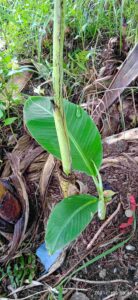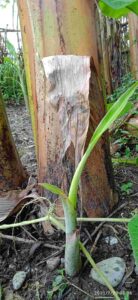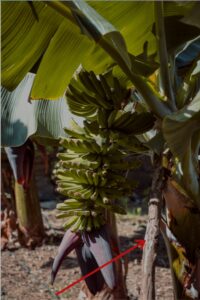Banana Farming
Banana is one of the most loved fruit. Banana farming is popular all over the world as it has high market demand and many health benefits. Banana is a monocot plant showing parthenocarpy i.e Development of fruit without fertilization (Seedless Fruit). It is monocarpic i.e Fruiting only once in a lifetime. It is a herbaceous Perennial plant with cymose inflorescence and inferior ovary. The stem of banana is called pseudostem because, It is not a stem technically. It is just tight clasping of leaf sheath. Infact, the true stem of Banana plant is Rhizome (Underground Shoot).
The fruit was originated in South East Asia (Indo-China Region).
The botanical name of banana is Musa paradisiaca. It falls under family, Musaceae. This family consists of 3 genus,
1. Ensete
2. Musa
3. Musella
Out of these three different genus, Most cultivated banana is from genus Musa.
Many people want to start their own Banana farming. But, the lack different knowledge on How to start Banana farming.
In this blog we are going to guide on how to start your own banana farming in detail.
Banana farming has become one of the most adopted business in agriculture because:-
✓The market of banana is good all round the year.
✓The investment is low whereas profit is high in banana farming.
✓Banana contains many good nutritional values. So, the demand is high.
✓We can harvest the banana for about 7 times by planting only once.
✓The maturing and harvesting period of banana is short.
✓It can be cultivated in most of the climatic condition and soil.
✓The problem of disease in banana farming is less.
Variety Selection
Selection of good variety is most important task while starting banana farming. Our production and profit depends upon the variety that we select for cultivation.
The common varieties of banana that are being cultivated from years are:- Musa acuminata(AA) and Musa balbisiana(BB). Most of the commercial varities are developed from the intraspecific cross of Musa acuminata and Musa balbisiana. These both varieties are diploid, But, The commercial varities that are cultivated nowadays are triploid in nature (AAB, ABB).
We have listed some of the good commercial varieties of Banana which have good production and taste:-
1.G-9
2..Muthia
3.Robusta/Harichal (AAA)
4.Red Banana
5.Dwarf cavendish/Basarai Dwarf (AAA)
6.Poovan (AAB)
7..Lady finger banana
8.Grand Nain
9.Monthan
10.Gross Michel
Some of the above varieties are explained below:-
✳️Dwarf Cavendish/Basari Dwarf
➡️ Small plant, Large sized fruit, Green peel colour, Soft flesh with sweetish taste. This variety is susceptible to Bunchy top and leaf spot disease but is resistant to Panama wilt. To know these diseases and defects, you can directly go on Disease section.
✳️Robusta
Semi-tall mutant of Dwarf Cavendish. It has better keeping quality of fruit.
✳️Poovan
This variety has vigorous growth. It is mutant of Malbhog variety of Banana. It is tall and hardy that can grow in unirrigated condition as well. This variety is resistant to Panama wilt but susceptible to stem brorer.
✳️Gros Michel
It ranks first in terms of fruit quality (Flavour, Taste, Skin Colour, Symmetry and Strength of bunch).
✳️ Giant Cavendish/William Hybrid
Tall mutant of Dwarf Cavendish, Resistant to Panama wilt but susceptible to sigatoka leaf spot disease.
Climate
Banana is fruit of Humid-Tropics. It can be cultivated upto 1000 masl. The area with the rainfall of (200-250) cm distributed throughout the year is considered good.
Propagation
As banana is Seedless Fruit, We have to do vegetative propagation. This tree can be propagated by the means of suckers. There are two types of suckers in Banana which are:-
1.Water Sucker
Water sucker has broad leaves. When propagated with water Suckers, we can get banana fruit within (15-16) months. (3-4) months old water Suckers are best for banana propagation.

2.Sword Sucker
They have narrow leaves which gives them sword like appearance. If propagated with Sword sucker, we can get fruits within 11 months.

Planting Season
The planting season for Banana is February and June.If You have good irrigation facility, then only you start in February. If there is not proper irrigation facility, then you should plant in june. If the variety you choose is susceptible to leaf spot, then – Adjust your planting time in such a way that bunch appreance doesn’t occur during rainy season. After (90-120) days of bunch appreance, The fruit is ready to harvest.
Soil
Loamy soil rich in organic matter with good drainage and pH (6-7.5) is considered good for banana farming. Soil depth should be (80-120) cm. A soil with abundant supply of K2O and Mg is good for banana farming.
Temperature
The temperature requirement for banana farming is (20-35)°C. Temperature greater than 35 and less than 20 retards the growth of banana.
High temperature is very bad for banana. Due to high temperature, we can see burning problems and growth stops in banana which greatly reduces our production.
If the temperature is low, Some effects are seen which are listed below:-
✓Firing Of Leaves
✓Stunted Growth
✓Choke Throat
Planting Distance And Area
The number of plants that we can plant in 1 acre area depends upon the plant-plant and row-row distance and this distance also depends on variety. On an average, the plant-plant and row-row distance is:-
➡️Plant-Plant Distance
4ft, 5ft and 6ft
➡️Row-Row Distance
6ft, 7ft, 8ft
➡️The best planting distance for almost all variety of banana is (4×8)ft.
On an average, we can plant about 900 plants/acre. Some people plant more trees in same area, but the production is not good and more management is required.The good spacing help in passing of air.
Irrigation
The soil shouldn’t be dry. We should irrigate in every (10-15) days. Frequent and light irrigation is best for banana farming
We plant banana by making bunds or by making ridges and furrows. In this case, drip irrigation is best method to irrigate bananas.
It is good to lay drip pipes on both sides of tree. This will make the roots strong and tree needs less support.
Drip irrigation also helps in fertigation process.Other method of irrigation is flooding method. In this method, we deliver water to the plants through furrows.
Fertilizers
The general recommendation of fertilizers for banana farming is 200gm N, 100-110 gm of P, 250 gm of K and (10-15) kg FYM per Plant per Year. We shouldn’t apply N, K at once. They are to be used in split doses.
For Nitrogen (N):-
➡️150 gm during vegetative Phase
➡️ 50 gm after bunch appreance (Reproductive Phase)
For Potassium (K):-
➡️150 gm during vegetative Phase
➡️100 gm during reproductive phase
The use of fertilizers makes the stem and base of plant more wider and stronger.
Note:-Some farmer got the problem of uneven height of banana trees in same field.
This problem arises because:-
People give same doses of fertilizer to all plants. So, we should give extra drenching(fertilizers) to small height bananas.
Harvesting
The flowering of banana starts after 6 to 7 months of planting. After 3 months of flowering, fruiting occurs.
So, we can start harvesting banana after 10 months of plantation or (90-120) days after bunching. Some harvesting index of Banana are:-
✓ The angularity of fruits changes to almost zero.
✓ The peel color changes, Usually from greem to yellow. There are some varieties whose peel colour doesn’t change and some change to Red.
Care And Management
We should do proper care during initial growth phase. We should check its growth and proper fertilizer should be applied.
When banana fruits, we should cover entire fruit with plastic. This will protect banana from insect mainly from mosquito.
The benefit of doing this is the quality if banana is very good and we can get good amount of money in market.
Note:- We should make small holes in plastic. This will ensure the flow of air up to banana fruit.
The leaves which get dry should be cut off and can be put in furrows between two ridges.
Sometimes, we need to stake the plant if it fruits many and becomes heavy.
Some common management practices to be followed during banana farming in order to get good harvest are explained below:-
1. De-Suckering

➡️ During vegetative phase, Banana produce many suckers but, we have to maintain only 2 suckers. De-Suckering is carried out in every 45 days. To kill these suckers, You can just make a hole in sucker stem and put kerosene or petrol. Then, It will die. Suckers are important for the plant propagation.
2. Earthing Up
➡️ Banana is a shallow rooted crop. So – It can be easily lodged during rainfall and high wind. Therefore, Earthing Up is necessary. It is just a process of placing the pile of soil at the base of stem from all sides.
3. Propping

➡️ As the banana is shallow rooted (40-45 cm), It is prone to lodging even during fruiting also. So – We should provide support with some woods. Support should be given at the base of bunch not in stem. If you are doing mass cultivation, then, It is better to use metal wires to support the banana tree.
4. Wrapping/Bagging Of Bunches

➡️ Bagging is done to protect the fruits from birds, insects, pests, to protect from low temperature and for early maturation. We should use white plastic with some holes. In region of too much cold, Double layer of plastic can be used for bagging.
5. Denavelling
➡️ Denavelling is the process of removal of male buds from the banana bunch. This helps in the production of uniform size fruits.
6. Mattocking

➡️ Banana is Monocarpic fruit. That means, when one pseudostem produce fruits, then – It will not produce another bunch of fruit in its whole life. So – It’s of no use. While the side suckers developing from the mother pseudostem can produce fruits. So, – What we do here is, we cut the main pseudostem. Mattocking is the process of the cutting down the stem of banana after its produces fruit. Though it is not gonna produce any fruit in future, This do have use. We should cut the stem by leaving the 60 cm above the ground. This 60 cm stubble works as nutrient source for other growing suckers. Cutting should be avoided during rainy season.
Diseases
At initial phase we face the problem of blight. The leaves becomes yellow and burning is seen in edge of leaves. This is caused by sigatoka virus.
After flowering and fruiting we may face the problem of mosquito. For this covering should be done.
Another disease in banana is its roots are attacked by fungus. To prevent this we can use different fungicides. We can also add sulphur which also acts as fungicide. The extra benefit we get by the application of sulphur is it maintains heat in soil.
Some common diseases in Banana are explained below along with their solution:-
1. Panama Wilt
It occurs in poorly drained soil. During wet condition of soil, it occurs as a fungal disease caused by Fusarium oxysporium. It is a soil borne disease.
In this disease, the leaves of banana just hand on the tree covering the whole stem from all side. It looks like wearing a sari. Under extreme condition, the leaves gets dry and die.
Solution:-
➡️ Unfortunately, This infection has no cure.
➡️ We can use Panama wilt resistant variety like Cavendish banana.
2. Leaf Spot (Sigatoka)
It is also a fungal disease caused by Cercospora muscae. It occurs due to high temperature. Initially, there occurs light green yellowish spot on the leaves. The spots increase in number and gets United ultimately coleasing the whole leaf.
Solution:-
➡️Apply 3 weekly spray of Bordeaux mixture with high volume sprayer in (10-12) cycle. Fungicide like Zineb, Dithene M45, Cuman are also seen effective.
3. Bunchy Top Of Banana
It is a viral disease transmitted by Aphid (Pentalonia nigronervosa). In this disease, The leaves are bunched together into a rosette at the top and their margin are wavy and slightly upward. Stunted growth and do not produce any bunch of commercial value.
Solution:-
➡️ Vector Control
➡️ Use Of Disease Resistance Variety
➡️ Remove the affected plant along with the rhizome immediately afte the symptoms are detected.
Pests In Banana Farming
Different kinds of pests attack the banana tree that can ruin the entire farming. So – It is better to know them and their control measures before starting the banana cultivation. Here, We have listed some common Banana Pests:-
1. Borer (Stem and Pseudostem Borer)
➡️Larvae bores into rhizome and Pseudostem and convert into adult and feed inside the banana tree affecting the vascular bundles which leads to less production.
Control:-Clean Cultivation
2. Banana Aphid
Aphid sucks the sap from phloem and also carries bunch top bannana virus.
Control:- Rogor, Malathion (0.1%)
3. Fruit and Leaf Scale Beetle
They feed on peel of young fruits and young leaves. They are nocturnal and appear during rainy season. They can be found inside round leaf at the centre top of the banana plant.
Control:- Clean Cultivation, Malathion (0.1%)
Investment And Income
On an average from buying seedling, planting, care and management to harvesting at once, we need to invest about 2 lakhs/acre.
If we talk about income, we can earn up to (8-9) lakhs/acre if we produce good quality bananas.
Note:- All the money is in indian currency.
Marketing
The market of bananas is good in all seasons. The main thing is there is always compition in market.
We can sell bananas according to their weight. We can earn good profit if we become able to grow good length bananas.
Buyers directly comes and visit our field and buy our production.
Tip:- We should invite many buyers and should sell to one who gives highest rate. This will increase our profit.
This is whole information on Banana Farming-Variety, Soil, Income, Management And Marketing.

I have learned so many things by reading this booklet.